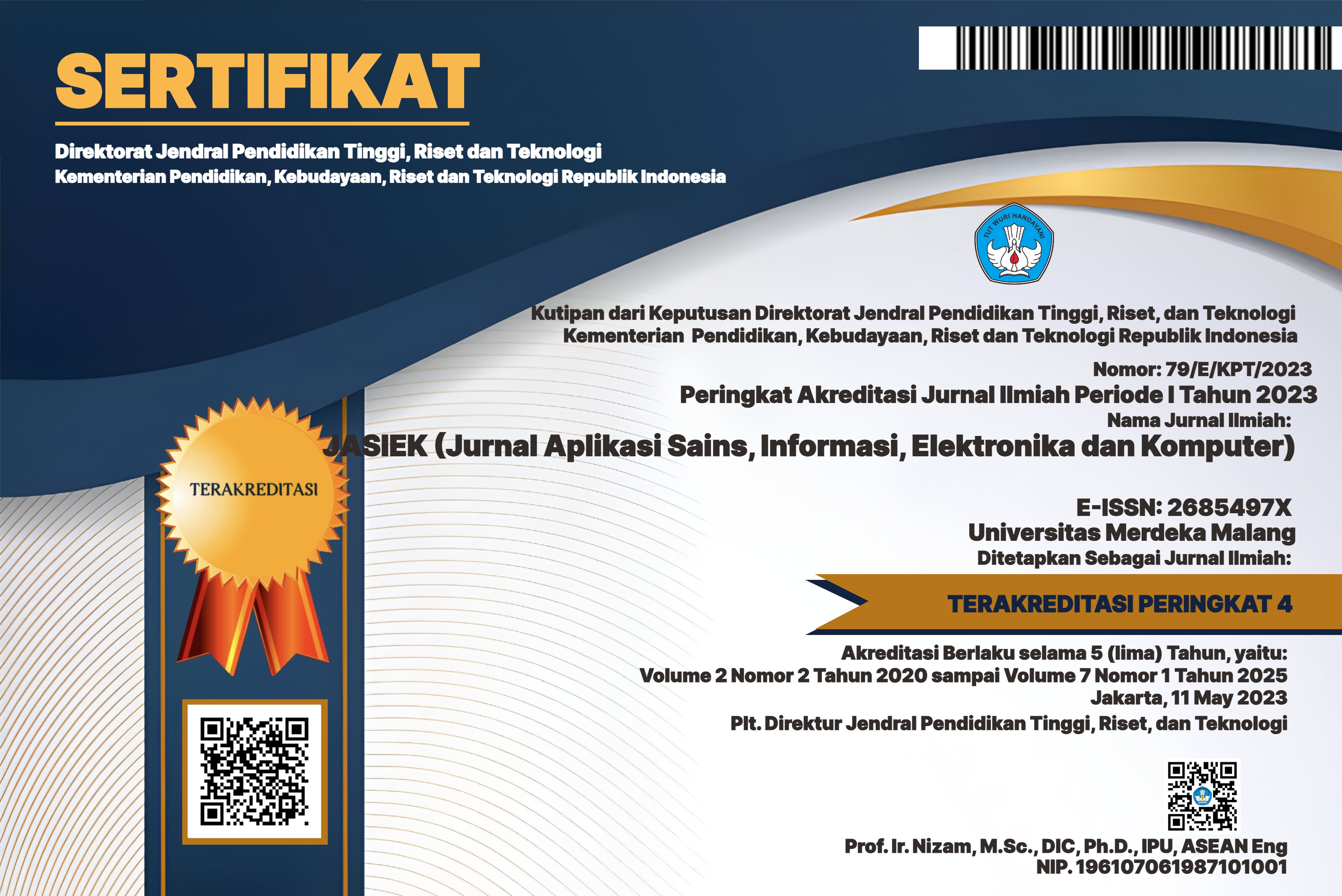PENGENDALI ROBOT BERODA BERBASIS SENSOR TELEMETRI VOICE PATTERN RECOGNITION
DOI:
https://doi.org/10.26905/jasiek.v1i1.3147Abstract
Pada perkembangan teknologi saat ini banyak dikembangkan jenis robot dengan kemampuan yang menarik adalah robot dengan pengendali suara manusia yang memanfaatkan teknologi pengenalan suara sebagai perintah untuk menggerakkan robot, sehingga robot bisa dikendalikan oleh suara manusia namun dalam hal ini dibutuhkan untuk keamanan perintah yang hanya mengenali suara user dengan menggunakan EasyVr, dan telepon seluler GSM dibutuhkan untuk mentransmisikan data suara dengan jarak jauh, karena proses pengiriman data menggunakan telepon seluler akan lebih efektif dan efisien. Easy Voice Commander sebagai perekam suara user sebanyak dua kali ucapan dengan kata yang sama dan modul EasyVR sebagai modul pengenalan suara yang selanjutnya perintah perintah akan diolah oleh mikrokontroler Arduino sehingga robot bisa bekerja dengan baik sesuai perintah suara dari user.
Â
Downloads
References
A. Widiyanto and N. Nuryanto, “Rancang Bangun Mobil Remote Control Android dengan Arduino,†Creat. Inf. Technol. J., 2018.
E. H. Helmi guntoro, Yoyo Somantri, “Rancang Bangun Magnetic Door Lock Menggunakan Keypad Dan Solenoid Berbasis Mikrokontroler Arduino Uno,†Electrans, 2013.
A. F. Hastawan, A. Hidayatno, and R. R. Isnanto, “Deteksi Sudut Menggunakan Kode Rantai Untuk Pengenalan Bangun Datar Dua Dimensi,†Transmisi, 2013.
R. Yuwono, I. Mujahidin, A. Mustofa, and Aisah, “Rectifier using UFO microstrip antenna as electromagnetic energy harvester,†Adv. Sci. Lett., 2015.
R. Bimarta, A. E. Putra, and A. Dharmawan, “Balancing Robot Menggunakan Metode Kendali Proporsional Integral Derivatif,†IJEIS (Indonesian J. Electron. Instrum. Syst., 2015.
M. F. Rahmat and M. Md Ghazaly, “Performance Comparison Between PID and Fuzzy Logic Controller In Position Control System Of DC Servomotor,†J. Teknol., 2013.
I. Mujahidin, “Directional 1900 MHz Square Patch Ring Slot Microstrip Antenna For WCDMA,†JEEMECS (Journal Electr. Eng. Mechatron. Comput. Sci., 2019.
J. T. Elektro, F. T. Industri, and U. K. Petra, “Kontrol PID Untuk Pengaturan Kecepatan Motor DC Dengan Metode Tuning Direct Synthesis,†vol. 4, no. 1, pp. 10–17, 2004.
R. L. Singgeta and Sompie, “Rancang Bangun Robot Boat Navigasi Tanpa Awak,†E-Journal Tek. Elektro Dan Komput., 2013.
A. Mukti, O. D. Nurhayati, and E. D. Widianto, “Rancang Bangun Sistem Kontrol Robot Line Follower Menggunakan Logika Fuzzy,†J. Teknol. dan Sist. Komput., 2017.
R. A. Brooks, “A Robust Layered Control System For A Mobile Robot,†IEEE J. Robot. Autom., 1986.
S. Faro, “Pelvic inflammatory disease,†in Clinical Gynecology, Second Edition, 2015.
Downloads
Published
Issue
Section
License
Authors who publish with this journal agree to the following terms:
The journal allow the authors to hold the copyright without restrictions and allow the authors to retain publishing rights without restrictions.
Authors retain copyright and grant the journal right of first publication with the work simultaneously licensed under a Creative Commons Attribution-ShareAlike 4.0 International License that allows others to share the work with an acknowledgement of the work's authorship and initial publication in this journal.
Authors are able to enter into separate, additional contractual arrangements for the non-exclusive distribution of the journal's published version of the work (e.g., post it to an institutional repository or publish it in a book), with an acknowledgement of its initial publication in this journal.
Authors are permitted and encouraged to post their work online (e.g., in institutional repositories or on their website) prior to and during the submission process, as it can lead to productive exchanges, as well as earlier and greater citation of published work (See The Effect of Open Access).

This work is licensed under a Creative Commons Attribution-ShareAlike 4.0 International License.










